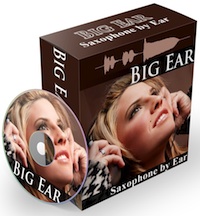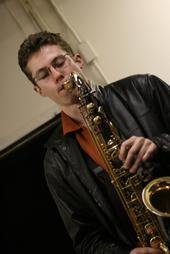Big Ear
(Would You Like to Be Able to Play the Music You Hear Without Hours of Frustration?)

Why take a class on music by ear?
For a long time I played music by reading, pretty much exclusively. It was restrictive though! You can only carry around so many ‘real books’ without breaking your back. And even then, you won’t have all the music you want to play.
Needing paper to play melodies, paper to improvise, you just don’t have enough freedom with the music. I got pretty good at sight reading, and it’s an important skill, but I neglected learning music by ear for quite a while. One day I went to a clinic with Bob Sheppard and I went up on stage. He asked me and a trumpet player if we knew ‘Bye Bye Blackbird’. I didn’t offhand. It was a little embarrassing. He tried to teach it to us on stage and I kind of got it. Would have felt much better if I knew it before he asked though.
That was a bit of a turning point for me. I started learning more music and practicing learning music by ear more. Found out it wasn’t nearly as hard as I had thought.
It seems like the majority of music is taught through reading for many people.
However, in the world of music, you absolutely need to listen to be able to play by ear. You can read some things on paper, but to really play, listening is fundamental and you’ll be able to access and play anything you hear. A computer can play back ‘music’ with rhythmic accuracy and the right pitches. But that’s not music. And you learn the other dimensions of music by listening.
“Reading or by ear?”
There are two major approaches to learning music. Reading and learning by ear. Many sax players are taught by reading music. However, you leave a huge part of music out of the picture if you can’t learn music by ear.
If you never saw a chart with diagrams or sheet music, it probably would actually make you take a lot longer to learn the basics of music. Learning by ear will take you beyond the basics though, since that’s what can’t be written very effectively on paper.
It’s somewhat like how you learn the rules of driving by reading a book first in order to get a permit that allows you go out and practice driving on the road.
You can drive with the assistance of maps, but a road map doesn’t have all the details. It has some large and important details – how the roads are laid out and in general how you get to your destination. But you really learn how to drive by getting out there and experiencing it. Much like you get into the music by listening and trying it.
Introducing The Big Ear Saxophone Class
We have a 6 week online class specifically designed for learning music on sax by ear…
It’s a systematic approach to learning the different dimensions of music through progressively more challenging pieces. You can work through them at your own pace in the comfort of your home or bring it with you.
The weekly lessons will be sent to via email and you can download all the files through Sax Station.
This class can be a challenge.
I also have an option if you have never tried learning music by ear that is a bit easier to get started with.
There are two choices for the class – standard (with the lessons only) and the Premium (with additional challenges). Full details are listed.
What Level Of Sax Player Is The ‘Big Ear’ Saxophone Class Built For?
This class is for saxophone players who have learned to play by reading music and would like a systematic way to improve their abilities to play music by ear. Complete beginners can also benefit since the lessons progress from a basic level as well as for players who can play but simply have not spent much time learning music by ear and do not know how to approach it.
Each week of the class has the following:
1. Audio lessons. You’ll hear music at tempo and slowed down, I’ll talk about what to listen for in the music. The difficulty of the music will progress in these lessons.
2. Applications. You’ll hear the dimensions of music that you are learning in real examples.
3. Challenges. These are challenges that you will work on. They may be hard at first, but you’ll be provided tools to help you with them including recordings that are slowed down and visual breakdowns of the dynamics, phrasing, articulation, and rhythm.
The class begins with small phrase of a song. You just listen at first. Since you need to know what to listen for, we take the different parts separately. You’ll listen for the notes, the rhythm, the articulation, and you’ll try out each pieces yourself.
The music will include blues, jazz, classical, latin music and more. Each lesson builds and becomes more challenging. And you can ask me questions along the way. The necessary musical theory and notation to help will also be taught.
The class lesson plan is structured across six weeks – as you progress through the lessons here are some of the areas you’ll work on:
• Scales and Interval Recognition
-Knowing a few scales and how they work will make learning all music by ear a lot easier. Getting a good foundation in harmony is an important step.
• Rhythm
-Rhythm is fundamental to music. Rhythm alone can create music. Notes without rhythm is not music.
• Articulation and Style
-Understanding articulation and how it affects the style of music will help you have fine control over your music and sound authentic in different styles.
• Tone & Emotion
Your tone on sax and emotion you bring isn’t about how wildly you move around on stage.
• Chords, Progressions, and Altered Chord tones
Getting a little farther into harmony will help you make more sense of the music.
• Space
What you don’t play is just as important as what you do. • Phrasing and dynamics
You can learn phrasing from sax players and also from other instruments and singers. It helps define your sound on saxophone and you can learn many things from listening.
• Saxophone Technique
There are techniques to sounding certain ways. You can’t necessarily learn them just by listening. But listening, experimentation, and asking will help you figure out how to get the sounds you want.
You want to try out things when you first learn them! You’ll see how it works in a real context. The foundation of the class will be real music which also makes it more fun to learn.
How To Sign Up
Click on the payment button below after picking the option you want and follow the instructions. You will receive a welcome email and once you do, send me an email! Let me know a bit about yourself, when you stared playing, and what you would like to accomplish with the saxophone.

FAQ
Complete Details Of The Saxophone Ear Training Class Format:
The audio files are in MP3 format. They should work on just about every computer and are easily placed onto MP3 players such as iPods. On the computer, I would recommend using Quicktime or iTunes – those programs are available on both Mac and PCs. PDF files can be read using the freely available Adobe reader.
Delivery: The lessons will be sent to you via email. They will be on password protected pages with links to download the files.
Payment Methods: Payments are preferred through Paypal, if you don’t have one they are easy to set up and you pay securely. You can also use your credit card with Paypal.
Currency: Payments are in US Dollars. Paypal automatically converts different currencies.
Compatibility: Macs and PCs both will perform perfectly fine with this class. However, if there are any technical issues, I will gladly help you with them.
Guarantee: Is there a guarantee? Of course. If you are unhappy with the class for any reason, if it’s not what you expected or not working for you, you be issued a prompt refund within 60 days. Support: Should you have any questions, don’t hesitate to email me about it. I’ll get back to you as soon as I can.
Important: Reasons Why You Should Sign Up Now
1)You’ll get to work through a progressive set of challenges and work with me directly.
2) Space is limited. I only have so much time to teach students. Once the space is filled, there will be a waiting list.
3) Zero Risk. Try out the class for thirty days. If you don’t think the class is right for you, for any reason, just email me and you will get a full refund. Feedback about what would make you like the class better will be appreciated, but I’ll only ask about that after you have your refund.
Neal Battaglia, Monterey

